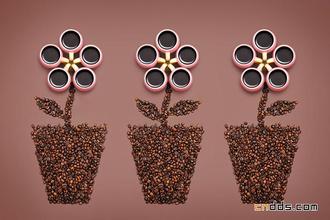Introduction of variety characteristics of taste treatment method for flavor description of coffee bean manor in Brazil
Introduction of variety characteristics of taste treatment method for flavor description of coffee bean manor in Brazil
Brazil has also proved to be able to produce gourmet coffee and small quantities of coffee, and the local boutique coffee can not only be provided by small-scale coffee farmers. The main coffee producing areas in Brazil are Sulde Minas South Minas, Matas de Minas Minas South East Mountain Forest, Cerrado Hirado, the north-central mausoleum of Chapadas de Minas Minas, Mogiana, Paran á Parana and Bahia Bachia. There are both traditional varieties and variants, such as Bourbon, Mondo Novo Mondonovo, Icat ú Ikatu, Kaduai, Iapar, cultivated card Taiyi. Producing area: Alta Mogiana region, S ã o Paulo
Estate: Fazenda Rainha Manor (Queen Farm)
Variety: yellow bourbon (Yellow Bourbon)
Altitude: average 1150 ft 1350 m
Treatment: natural sun drying
Flavor features: balanced sweet, creamy smooth, orange, apricot and other fruit flavor, chocolate, caramel flavor. Coffee was first introduced to Brazil in the early 18th century. In 1727, the Brazilian government sent a personable army officer to secretly bring coffee seeds from French Gaiana to Brazil on the pretext of mediating border disputes. It is said that the governor's wife of French Gayana was so fascinated by the officer that she secretly brought coffee tree seeds to him at a farewell dinner party. At present, 2 million hectares of land in Brazil is used to grow coffee, and the largest is Arabica. These beans will eventually be sent to large bakers in various countries, also known as Santos (in the name of the port of export santos, not the producing area).

Important Notice :
前街咖啡 FrontStreet Coffee has moved to new addredd:
FrontStreet Coffee Address: 315,Donghua East Road,GuangZhou
Tel:020 38364473
- Prev

Description of characteristics and Flavor of Brazilian Coffee Bean introduction to the method of Regional treatment of varieties produced by Grinding scale
Brazilian coffee bean characteristic flavor description grinding scale variety production regional treatment method Brazil is vividly compared to the giant and monarch of the coffee world. There are about 3.97 billion coffee trees there, and small farmers now grow 75% of Brazil's total coffee production. Brazil produces twice or even three times as many coffee as Colombia, which is the second largest coffee producer in the world.
- Next

The flavor description of the washed coffee beans.
Yegashefi g1 Washed Coffee Bean Flavor Description Grind Scale Production Area Treatment Introduction Yegashefi is produced at the Kebel Aricha Processing Plant, near which about 650-700 small coffee farmers send ripe coffee berries for processing and cash. After the processing plant selects the available berries, they are directly placed on the shelf for exposure. The first few days of drying will be turned every 2-3 hours.
Related
- Detailed explanation of Jadeite planting Land in Panamanian Jadeite Manor introduction to the grading system of Jadeite competitive bidding, Red bid, Green bid and Rose Summer
- Story of Coffee planting in Brenka region of Costa Rica Stonehenge Manor anaerobic heavy honey treatment of flavor mouth
- What's on the barrel of Blue Mountain Coffee beans?
- Can American coffee also pull flowers? How to use hot American style to pull out a good-looking pattern?
- Can you make a cold extract with coffee beans? What is the right proportion for cold-extracted coffee formula?
- Indonesian PWN Gold Mandrine Coffee Origin Features Flavor How to Chong? Mandolin coffee is American.
- A brief introduction to the flavor characteristics of Brazilian yellow bourbon coffee beans
- What is the effect of different water quality on the flavor of cold-extracted coffee? What kind of water is best for brewing coffee?
- Why do you think of Rose Summer whenever you mention Panamanian coffee?
- Introduction to the characteristics of authentic blue mountain coffee bean producing areas? What is the CIB Coffee Authority in Jamaica?

